Zhaowei Li
Decoupled Proxy Alignment: Mitigating Language Prior Conflict for Multimodal Alignment in MLLM
Sep 18, 2025Abstract:Multimodal large language models (MLLMs) have gained significant attention due to their impressive ability to integrate vision and language modalities. Recent advancements in MLLMs have primarily focused on improving performance through high-quality datasets, novel architectures, and optimized training strategies. However, in this paper, we identify a previously overlooked issue, language prior conflict, a mismatch between the inherent language priors of large language models (LLMs) and the language priors in training datasets. This conflict leads to suboptimal vision-language alignment, as MLLMs are prone to adapting to the language style of training samples. To address this issue, we propose a novel training method called Decoupled Proxy Alignment (DPA). DPA introduces two key innovations: (1) the use of a proxy LLM during pretraining to decouple the vision-language alignment process from language prior interference, and (2) dynamic loss adjustment based on visual relevance to strengthen optimization signals for visually relevant tokens. Extensive experiments demonstrate that DPA significantly mitigates the language prior conflict, achieving superior alignment performance across diverse datasets, model families, and scales. Our method not only improves the effectiveness of MLLM training but also shows exceptional generalization capabilities, making it a robust approach for vision-language alignment. Our code is available at https://github.com/fnlp-vision/DPA.
UnifiedVisual: A Framework for Constructing Unified Vision-Language Datasets
Sep 18, 2025Abstract:Unified vision large language models (VLLMs) have recently achieved impressive advancements in both multimodal understanding and generation, powering applications such as visual question answering and text-guided image synthesis. However, progress in unified VLLMs remains constrained by the lack of datasets that fully exploit the synergistic potential between these two core abilities. Existing datasets typically address understanding and generation in isolation, thereby limiting the performance of unified VLLMs. To bridge this critical gap, we introduce a novel dataset construction framework, UnifiedVisual, and present UnifiedVisual-240K, a high-quality dataset meticulously designed to facilitate mutual enhancement between multimodal understanding and generation. UnifiedVisual-240K seamlessly integrates diverse visual and textual inputs and outputs, enabling comprehensive cross-modal reasoning and precise text-to-image alignment. Our dataset encompasses a wide spectrum of tasks and data sources, ensuring rich diversity and addressing key shortcomings of prior resources. Extensive experiments demonstrate that models trained on UnifiedVisual-240K consistently achieve strong performance across a wide range of tasks. Notably, these models exhibit significant mutual reinforcement between multimodal understanding and generation, further validating the effectiveness of our framework and dataset. We believe UnifiedVisual represents a new growth point for advancing unified VLLMs and unlocking their full potential. Our code and datasets is available at https://github.com/fnlp-vision/UnifiedVisual.
QuantV2X: A Fully Quantized Multi-Agent System for Cooperative Perception
Sep 03, 2025Abstract:Cooperative perception through Vehicle-to-Everything (V2X) communication offers significant potential for enhancing vehicle perception by mitigating occlusions and expanding the field of view. However, past research has predominantly focused on improving accuracy metrics without addressing the crucial system-level considerations of efficiency, latency, and real-world deployability. Noticeably, most existing systems rely on full-precision models, which incur high computational and transmission costs, making them impractical for real-time operation in resource-constrained environments. In this paper, we introduce \textbf{QuantV2X}, the first fully quantized multi-agent system designed specifically for efficient and scalable deployment of multi-modal, multi-agent V2X cooperative perception. QuantV2X introduces a unified end-to-end quantization strategy across both neural network models and transmitted message representations that simultaneously reduces computational load and transmission bandwidth. Remarkably, despite operating under low-bit constraints, QuantV2X achieves accuracy comparable to full-precision systems. More importantly, when evaluated under deployment-oriented metrics, QuantV2X reduces system-level latency by 3.2$\times$ and achieves a +9.5 improvement in mAP30 over full-precision baselines. Furthermore, QuantV2X scales more effectively, enabling larger and more capable models to fit within strict memory budgets. These results highlight the viability of a fully quantized multi-agent intermediate fusion system for real-world deployment. The system will be publicly released to promote research in this field: https://github.com/ucla-mobility/QuantV2X.
Kimi K2: Open Agentic Intelligence
Jul 28, 2025Abstract:We introduce Kimi K2, a Mixture-of-Experts (MoE) large language model with 32 billion activated parameters and 1 trillion total parameters. We propose the MuonClip optimizer, which improves upon Muon with a novel QK-clip technique to address training instability while enjoying the advanced token efficiency of Muon. Based on MuonClip, K2 was pre-trained on 15.5 trillion tokens with zero loss spike. During post-training, K2 undergoes a multi-stage post-training process, highlighted by a large-scale agentic data synthesis pipeline and a joint reinforcement learning (RL) stage, where the model improves its capabilities through interactions with real and synthetic environments. Kimi K2 achieves state-of-the-art performance among open-source non-thinking models, with strengths in agentic capabilities. Notably, K2 obtains 66.1 on Tau2-Bench, 76.5 on ACEBench (En), 65.8 on SWE-Bench Verified, and 47.3 on SWE-Bench Multilingual -- surpassing most open and closed-sourced baselines in non-thinking settings. It also exhibits strong capabilities in coding, mathematics, and reasoning tasks, with a score of 53.7 on LiveCodeBench v6, 49.5 on AIME 2025, 75.1 on GPQA-Diamond, and 27.1 on OJBench, all without extended thinking. These results position Kimi K2 as one of the most capable open-source large language models to date, particularly in software engineering and agentic tasks. We release our base and post-trained model checkpoints to facilitate future research and applications of agentic intelligence.
Automated Sentiment Classification and Topic Discovery in Large-Scale Social Media Streams
May 03, 2025Abstract:We present a framework for large-scale sentiment and topic analysis of Twitter discourse. Our pipeline begins with targeted data collection using conflict-specific keywords, followed by automated sentiment labeling via multiple pre-trained models to improve annotation robustness. We examine the relationship between sentiment and contextual features such as timestamp, geolocation, and lexical content. To identify latent themes, we apply Latent Dirichlet Allocation (LDA) on partitioned subsets grouped by sentiment and metadata attributes. Finally, we develop an interactive visualization interface to support exploration of sentiment trends and topic distributions across time and regions. This work contributes a scalable methodology for social media analysis in dynamic geopolitical contexts.
Kimi-VL Technical Report
Apr 10, 2025Abstract:We present Kimi-VL, an efficient open-source Mixture-of-Experts (MoE) vision-language model (VLM) that offers advanced multimodal reasoning, long-context understanding, and strong agent capabilities - all while activating only 2.8B parameters in its language decoder (Kimi-VL-A3B). Kimi-VL demonstrates strong performance across challenging domains: as a general-purpose VLM, Kimi-VL excels in multi-turn agent tasks (e.g., OSWorld), matching flagship models. Furthermore, it exhibits remarkable capabilities across diverse challenging vision language tasks, including college-level image and video comprehension, OCR, mathematical reasoning, and multi-image understanding. In comparative evaluations, it effectively competes with cutting-edge efficient VLMs such as GPT-4o-mini, Qwen2.5-VL-7B, and Gemma-3-12B-IT, while surpassing GPT-4o in several key domains. Kimi-VL also advances in processing long contexts and perceiving clearly. With a 128K extended context window, Kimi-VL can process diverse long inputs, achieving impressive scores of 64.5 on LongVideoBench and 35.1 on MMLongBench-Doc. Its native-resolution vision encoder, MoonViT, further allows it to see and understand ultra-high-resolution visual inputs, achieving 83.2 on InfoVQA and 34.5 on ScreenSpot-Pro, while maintaining lower computational cost for common tasks. Building upon Kimi-VL, we introduce an advanced long-thinking variant: Kimi-VL-Thinking. Developed through long chain-of-thought (CoT) supervised fine-tuning (SFT) and reinforcement learning (RL), this model exhibits strong long-horizon reasoning capabilities. It achieves scores of 61.7 on MMMU, 36.8 on MathVision, and 71.3 on MathVista while maintaining the compact 2.8B activated LLM parameters, setting a new standard for efficient multimodal thinking models. Code and models are publicly accessible at https://github.com/MoonshotAI/Kimi-VL.
Advancing Fine-Grained Visual Understanding with Multi-Scale Alignment in Multi-Modal Models
Nov 14, 2024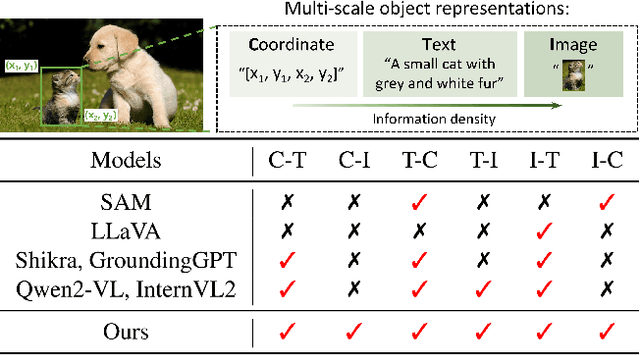
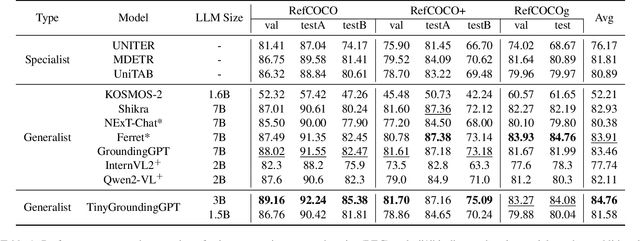
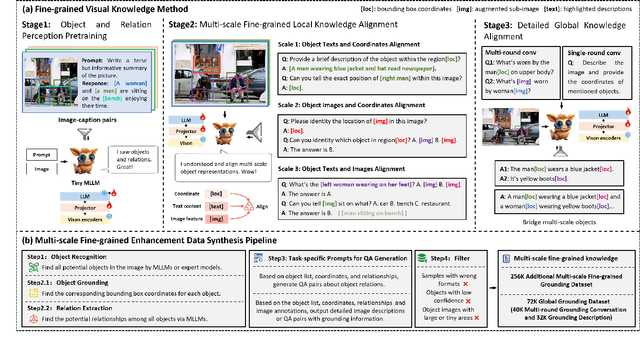
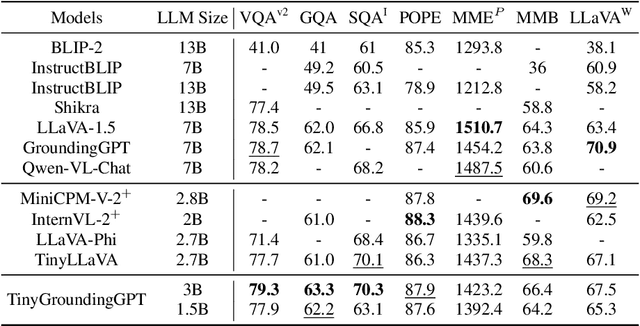
Abstract:Multi-modal large language models (MLLMs) have achieved remarkable success in fine-grained visual understanding across a range of tasks. However, they often encounter significant challenges due to inadequate alignment for fine-grained knowledge, which restricts their ability to accurately capture local details and attain a comprehensive global perception. While recent advancements have focused on aligning object expressions with grounding information, they typically lack explicit integration of object images, which contain affluent information beyond mere texts or coordinates. To bridge this gap, we introduce a novel fine-grained visual knowledge alignment method that effectively aligns and integrates multi-scale knowledge of objects, including texts, coordinates, and images. This innovative method is underpinned by our multi-scale fine-grained enhancement data synthesis pipeline, which provides over 300K essential training data to enhance alignment and improve overall performance. Furthermore, we present TinyGroundingGPT, a series of compact models optimized for high-level alignments. With a scale of approximately 3B parameters, TinyGroundingGPT achieves outstanding results in grounding tasks while delivering performance comparable to larger MLLMs in complex visual scenarios.
Understanding the Role of LLMs in Multimodal Evaluation Benchmarks
Oct 16, 2024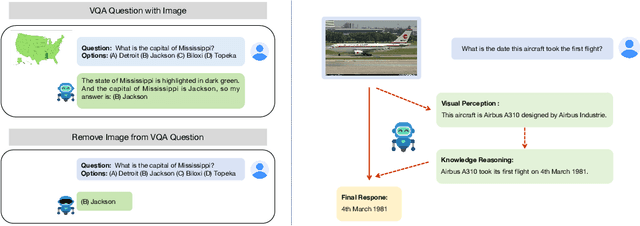
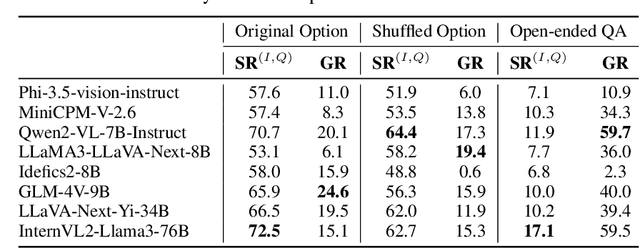
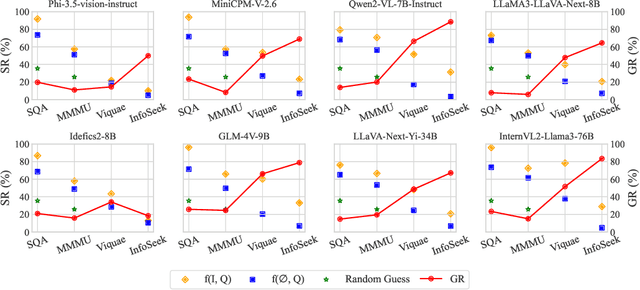

Abstract:The rapid advancement of Multimodal Large Language Models (MLLMs) has been accompanied by the development of various benchmarks to evaluate their capabilities. However, the true nature of these evaluations and the extent to which they assess multimodal reasoning versus merely leveraging the underlying Large Language Model (LLM) backbone remain unclear. This paper presents a comprehensive investigation into the role of LLM backbones in MLLM evaluation, focusing on two critical aspects: the degree to which current benchmarks truly assess multimodal reasoning and the influence of LLM prior knowledge on performance. Specifically, we introduce a modified evaluation protocol to disentangle the contributions of the LLM backbone from multimodal integration, and an automatic knowledge identification technique for diagnosing whether LLMs equip the necessary knowledge for corresponding multimodal questions. Our study encompasses four diverse MLLM benchmarks and eight state-of-the-art MLLMs. Key findings reveal that some benchmarks allow high performance even without visual inputs and up to 50\% of error rates can be attributed to insufficient world knowledge in the LLM backbone, indicating a heavy reliance on language capabilities. To address knowledge deficiencies, we propose a knowledge augmentation pipeline that achieves significant performance gains, with improvements of up to 60\% on certain datasets, resulting in a approximately 4x increase in performance. Our work provides crucial insights into the role of the LLM backbone in MLLMs, and highlights the need for more nuanced benchmarking approaches.
UnifiedMLLM: Enabling Unified Representation for Multi-modal Multi-tasks With Large Language Model
Aug 05, 2024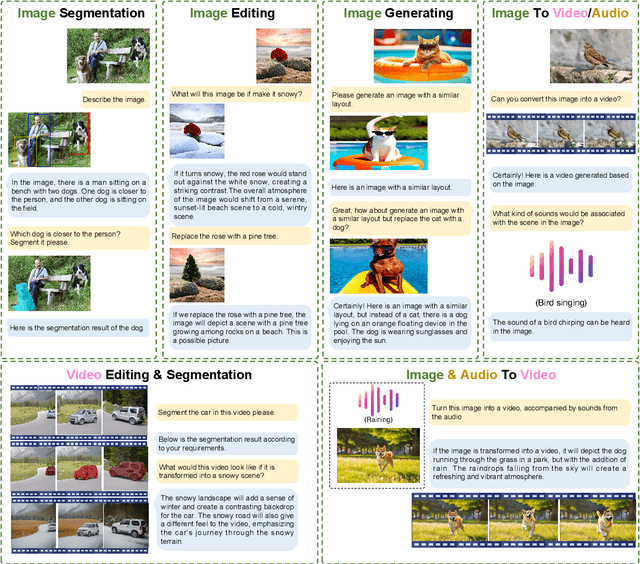

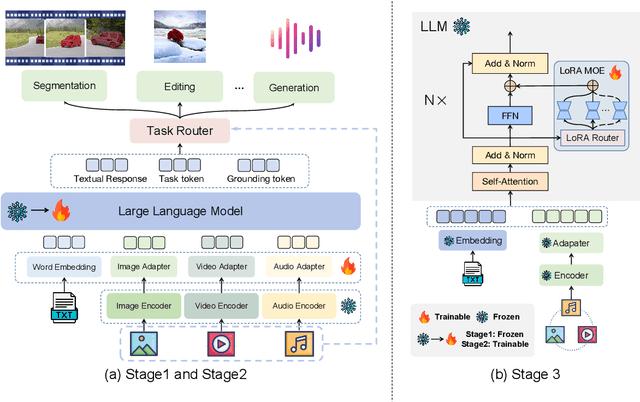

Abstract:Significant advancements has recently been achieved in the field of multi-modal large language models (MLLMs), demonstrating their remarkable capabilities in understanding and reasoning across diverse tasks. However, these models are often trained for specific tasks and rely on task-specific input-output formats, limiting their applicability to a broader range of tasks. This raises a fundamental question: Can we develop a unified approach to represent and handle different multi-modal tasks to maximize the generalizability of MLLMs? In this paper, we propose UnifiedMLLM, a comprehensive model designed to represent various tasks using a unified representation. Our model exhibits strong capabilities in comprehending the implicit intent of user instructions and preforming reasoning. In addition to generating textual responses, our model also outputs task tokens and grounding tokens, serving as indicators of task types and task granularity. These outputs are subsequently routed through the task router and directed to specific expert models for task completion. To train our model, we construct a task-specific dataset and an 100k multi-task dataset encompassing complex scenarios. Employing a three-stage training strategy, we equip our model with robust reasoning and task processing capabilities while preserving its generalization capacity and knowledge reservoir. Extensive experiments showcase the impressive performance of our unified representation approach across various tasks, surpassing existing methodologies. Furthermore, our approach exhibits exceptional scalability and generality. Our code, model, and dataset will be available at \url{https://github.com/lzw-lzw/UnifiedMLLM}.
SpeechAlign: Aligning Speech Generation to Human Preferences
Apr 08, 2024Abstract:Speech language models have significantly advanced in generating realistic speech, with neural codec language models standing out. However, the integration of human feedback to align speech outputs to human preferences is often neglected. This paper addresses this gap by first analyzing the distribution gap in codec language models, highlighting how it leads to discrepancies between the training and inference phases, which negatively affects performance. Then we explore leveraging learning from human feedback to bridge the distribution gap. We introduce SpeechAlign, an iterative self-improvement strategy that aligns speech language models to human preferences. SpeechAlign involves constructing a preference codec dataset contrasting golden codec tokens against synthetic tokens, followed by preference optimization to improve the codec language model. This cycle of improvement is carried out iteratively to steadily convert weak models to strong ones. Through both subjective and objective evaluations, we show that SpeechAlign can bridge the distribution gap and facilitating continuous self-improvement of the speech language model. Moreover, SpeechAlign exhibits robust generalization capabilities and works for smaller models. Code and models will be available at https://github.com/0nutation/SpeechGPT.
 Add to Chrome
Add to Chrome Add to Firefox
Add to Firefox Add to Edge
Add to Edge